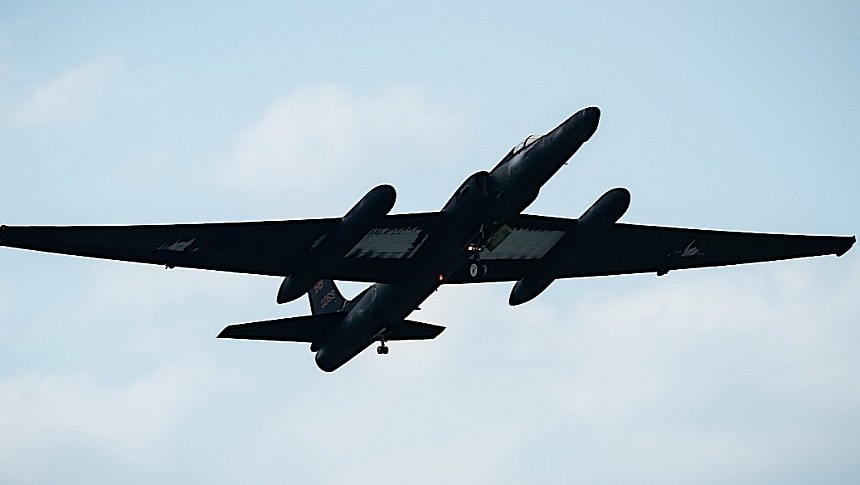There are a number of high-profile and very advanced aircraft in the inventory of the U.S. Air Force (USAF), and the military branch does not shy away from advertising their exploits every chance it gets. But there are flying machines that through the nature of the job need a lot more discretion.
The U-2 Dragon Lady spy plane is one of them. It's a name we don't come across very often in the public space, not in small part due to the fact it is, by its nature, used to staying in the shadows. Or should we say high above the clouds, the place from where it likes to operate.
The spy plane was born all the way back in 1955, at the height of the Cold War, at the hands of Lockheed as an intelligence, surveillance and reconnaissance (ISR) aircraft. It is powered by a single General Electric turbofan engine capable of developing 17,000 pounds of thrust.
That may not seem all that much, given what more modern planes are capable of, but it does give the plane a top speed of 410 mph (660 kph). A low number for airplanes, but this one needs to fly slowly to be able to capture the secrets of the enemy.
And it does so from an altitude that can reach a staggering 70,000 feet (over 21,000 meters). More than that, the plane can stay airborne for as much as 7,000 miles (11,265 km) and virtually forever when refueled by aerial tankers.
The above are impressive numbers, but this being an almost seven-decades-old plane means many of its systems are in need of replacement. And that's exactly what Lockheed Martin Skunk Works is doing, with the latest development on the work performed proudly shared by the company this week.
At the time of writing Lockheed is working on upgrading the plane through something called the Avionics Tech Refresh (ATR) program. The new hardware suite targets a number of the plane's systems, including avionics, the mission computer, and cockpit displays, and it was just flown for the first time on the plane.
The changes made in avionics are meant to allow the integration of new communication and navigation technologies. The new computer will now integrate with air, space, land, and cyber systems, while the new displays are more in tune with the times and what the pilot needs to see when operating the aircraft.
The test flight had a U-2 equipped with the ATR fly a low-altitude mission over an undisclosed area, and it was deemed a success by Lockheed and the U.S. Air Force (USAF).
Further tests are needed, of course, to prove the upgrades work as expected, and only after the all-clear is given will the ATR be deployed across the 33-plane fleet. We're not given a timetable as to when that's expected to happen.
Lockheed Martin has been working on the project for three years now, after it received a $50 million contract for the upgrades back in 2020.
The spy plane was born all the way back in 1955, at the height of the Cold War, at the hands of Lockheed as an intelligence, surveillance and reconnaissance (ISR) aircraft. It is powered by a single General Electric turbofan engine capable of developing 17,000 pounds of thrust.
That may not seem all that much, given what more modern planes are capable of, but it does give the plane a top speed of 410 mph (660 kph). A low number for airplanes, but this one needs to fly slowly to be able to capture the secrets of the enemy.
And it does so from an altitude that can reach a staggering 70,000 feet (over 21,000 meters). More than that, the plane can stay airborne for as much as 7,000 miles (11,265 km) and virtually forever when refueled by aerial tankers.
The above are impressive numbers, but this being an almost seven-decades-old plane means many of its systems are in need of replacement. And that's exactly what Lockheed Martin Skunk Works is doing, with the latest development on the work performed proudly shared by the company this week.
At the time of writing Lockheed is working on upgrading the plane through something called the Avionics Tech Refresh (ATR) program. The new hardware suite targets a number of the plane's systems, including avionics, the mission computer, and cockpit displays, and it was just flown for the first time on the plane.
The changes made in avionics are meant to allow the integration of new communication and navigation technologies. The new computer will now integrate with air, space, land, and cyber systems, while the new displays are more in tune with the times and what the pilot needs to see when operating the aircraft.
The test flight had a U-2 equipped with the ATR fly a low-altitude mission over an undisclosed area, and it was deemed a success by Lockheed and the U.S. Air Force (USAF).
Further tests are needed, of course, to prove the upgrades work as expected, and only after the all-clear is given will the ATR be deployed across the 33-plane fleet. We're not given a timetable as to when that's expected to happen.
Lockheed Martin has been working on the project for three years now, after it received a $50 million contract for the upgrades back in 2020.








